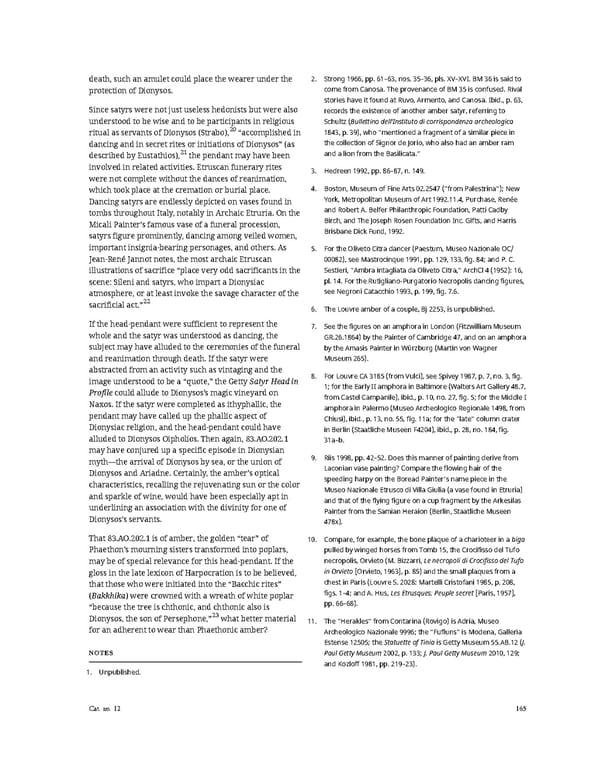death, such an amulet could place the wearer under the 2. Strong 1966, pp. 61–63, nos. 35–36, pls. XV–XVI. BM 36 is said to protection of Dionysos. come from Canosa. The provenance of BM 35 is confused. Rival stories have it found at Ruvo, Armento, and Canosa. Ibid., p. 63, Since satyrs were not just useless hedonists but were also records the existence of another amber satyr, referring to understood to be wise and to be participants in religious Schultz (Bullettino dell’Instituto di corrispondenza archeologica ritual as servants of Dionysos (Strabo),20 “accomplished in 1843, p. 39), who “mentioned a fragment of a similar piece in dancing and in secret rites or initiations of Dionysos” (as the collection of Signor de Jorio, who also had an amber ram described by Eustathios),21 the pendant may have been and a lion from the Basilicata.” involved in related activities. Etruscan funerary rites 3. Hedreen 1992, pp. 86–87, n. 149. were not complete without the dances of reanimation, which took place at the cremation or burial place. 4. Boston, Museum of Fine Arts 02.2547 (“from Palestrina”); New Dancing satyrs are endlessly depicted on vases found in York, Metropolitan Museum of Art 1992.11.4, Purchase, Renée tombs throughout Italy, notably in Archaic Etruria. On the and Robert A. Belfer Philanthropic Foundation, Patti Cadby Micali Painter’s famous vase of a funeral procession, Birch, and The Joseph Rosen Foundation Inc. Gifts, and Harris satyrs figure prominently, dancing among veiled women, Brisbane Dick Fund, 1992. important insignia-bearing personages, and others. As 5. For the Oliveto Citra dancer (Paestum, Museo Nazionale OC/ Jean-René Jannot notes, the most archaic Etruscan 00082), see Mastrocinque 1991, pp. 129, 133, fig. 84; and P. C. illustrations of sacrifice “place very odd sacrificants in the Sestieri, “Ambra intagliata da Oliveto Citra,” ArchCl 4 (1952): 16, scene: Sileni and satyrs, who impart a Dionysiac pl. 14. For the Rutigliano-Purgatorio Necropolis dancing figures, atmosphere, or at least invoke the savage character of the seeNegroni Catacchio 1993, p. 199, fig. 7.6. sacrificial act.”22 6. The Louvre amber of a couple, Bj 2253, is unpublished. If the head-pendant were sufficient to represent the 7. See the figures on an amphora in London (Fitzwilliam Museum whole and the satyr was understood as dancing, the GR.26.1864) by the Painter of Cambridge 47, and on an amphora subject may have alluded to the ceremonies of the funeral by the Amasis Painter in Würzburg (Martin von Wagner and reanimation through death. If the satyr were Museum 265). abstracted from an activity such as vintaging and the 8. For Louvre CA 3185 (from Vulci), see Spivey 1987, p. 7, no. 3, fig. image understood to be a “quote,” the Getty Satyr Head in 1; for the Early II amphora in Baltimore (Walters Art Gallery 48.7, Profile could allude to Dionysos’s magic vineyard on from Castel Campanile), ibid., p. 10, no. 27, fig. 5; for the Middle I Naxos. If the satyr were completed as ithyphallic, the amphora in Palermo (Museo Archeologico Regionale 1498, from pendant may have called up the phallic aspect of Chiusi), ibid., p. 13, no. 55, fig. 11a; for the “late” column crater Dionysiac religion, and the head-pendant could have in Berlin (Staatliche Museen F4204), ibid., p. 28, no. 184, fig. alluded to Dionysos Oipholios. Then again, 83.AO.202.1 31a–b. may have conjured up a specific episode in Dionysian myth—the arrival of Dionysos by sea, or the union of 9. Riis 1998, pp. 42–52. Does this manner of painting derive from Dionysos and Ariadne. Certainly, the amber’s optical Laconian vase painting? Compare the flowing hair of the characteristics, recalling the rejuvenating sun or the color speeding harpy on the Boread Painter’s name piece in the and sparkle of wine, would have been especially apt in Museo Nazionale Etrusco di Villa Giulia (a vase found in Etruria) underlining an association with the divinity for one of and that of the flying figure on a cup fragment by the Arkesilas Dionysos’s servants. Painter from the Samian Heraion (Berlin, Staatliche Museen 478x). That 83.AO.202.1 is of amber, the golden “tear” of 10. Compare, for example, the bone plaque of a charioteer in a biga Phaethon’s mourning sisters transformed into poplars, pulled by winged horses from Tomb 15, the Crocifisso del Tufo may be of special relevance for this head-pendant. If the necropolis, Orvieto (M. Bizzarri, Le necropoli di Crocifisso del Tufo gloss in the late lexicon of Harpocration is to be believed, in Orvieto [Orvieto, 1963], p. 85) and the small plaques from a that those who were initiated into the “Bacchic rites” chest in Paris (Louvre S. 2028: Martelli Cristofani 1985, p. 208, (Bakkhika) were crowned with a wreath of white poplar figs. 1–4; and A. Hus, Les Etrusques: Peuple secret [Paris, 1957], “because the tree is chthonic, and chthonic also is pp. 66–68). Dionysos, the son of Persephone,”23 what better material 11. The “Herakles” from Contarina (Rovigo) is Adria, Museo for an adherent to wear than Phaethonic amber? Archeologico Nazionale 9996; the “Fufluns” is Modena, Galleria Estense 12505; the Statuette of Tinia is Getty Museum 55.AB.12 (J. NOTES Paul Getty Museum 2002, p. 133; J. Paul Getty Museum 2010, 129; andKozloff 1981, pp. 219–23). 1. Unpublished. Cat. no. 12 165
 Ancient Carved Ambers in the J. Paul Getty Museum Page 174 Page 176
Ancient Carved Ambers in the J. Paul Getty Museum Page 174 Page 176